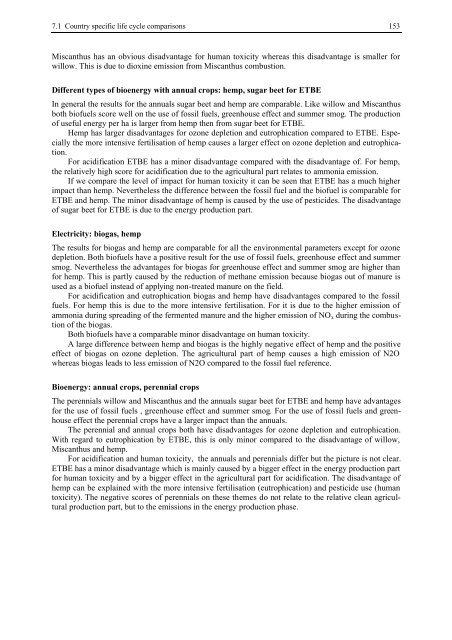BIOENERGY FOR EUROPE: WHICH ONES FIT BEST?
BIOENERGY FOR EUROPE: WHICH ONES FIT BEST?
BIOENERGY FOR EUROPE: WHICH ONES FIT BEST?
Create successful ePaper yourself
Turn your PDF publications into a flip-book with our unique Google optimized e-Paper software.
7.1 Country specific life cycle comparisons 153<br />
Miscanthus has an obvious disadvantage for human toxicity whereas this disadvantage is smaller for<br />
willow. This is due to dioxine emission from Miscanthus combustion.<br />
Different types of bioenergy with annual crops: hemp, sugar beet for ETBE<br />
In general the results for the annuals sugar beet and hemp are comparable. Like willow and Miscanthus<br />
both biofuels score well on the use of fossil fuels, greenhouse effect and summer smog. The production<br />
of useful energy per ha is larger from hemp then from sugar beet for ETBE.<br />
Hemp has larger disadvantages for ozone depletion and eutrophication compared to ETBE. Especially<br />
the more intensive fertilisation of hemp causes a larger effect on ozone depletion and eutrophication.<br />
For acidification ETBE has a minor disadvantage compared with the disadvantage of. For hemp,<br />
the relatively high score for acidification due to the agricultural part relates to ammonia emission.<br />
If we compare the level of impact for human toxicity it can be seen that ETBE has a much higher<br />
impact than hemp. Nevertheless the difference between the fossil fuel and the biofuel is comparable for<br />
ETBE and hemp. The minor disadvantage of hemp is caused by the use of pesticides. The disadvantage<br />
of sugar beet for ETBE is due to the energy production part.<br />
Electricity: biogas, hemp<br />
The results for biogas and hemp are comparable for all the environmental parameters except for ozone<br />
depletion. Both biofuels have a positive result for the use of fossil fuels, greenhouse effect and summer<br />
smog. Nevertheless the advantages for biogas for greenhouse effect and summer smog are higher than<br />
for hemp. This is partly caused by the reduction of methane emission because biogas out of manure is<br />
used as a biofuel instead of applying non-treated manure on the field.<br />
For acidification and eutrophication biogas and hemp have disadvantages compared to the fossil<br />
fuels. For hemp this is due to the more intensive fertilisation. For it is due to the higher emission of<br />
ammonia during spreading of the fermented manure and the higher emission of NOx during the combustion<br />
of the biogas.<br />
Both biofuels have a comparable minor disadvantage on human toxicity.<br />
A large difference between hemp and biogas is the highly negative effect of hemp and the positive<br />
effect of biogas on ozone depletion. The agricultural part of hemp causes a high emission of N2O<br />
whereas biogas leads to less emission of N2O compared to the fossil fuel reference.<br />
Bioenergy: annual crops, perennial crops<br />
The perennials willow and Miscanthus and the annuals sugar beet for ETBE and hemp have advantages<br />
for the use of fossil fuels , greenhouse effect and summer smog. For the use of fossil fuels and greenhouse<br />
effect the perennial crops have a larger impact than the annuals.<br />
The perennial and annual crops both have disadvantages for ozone depletion and eutrophication.<br />
With regard to eutrophication by ETBE, this is only minor compared to the disadvantage of willow,<br />
Miscanthus and hemp.<br />
For acidification and human toxicity, the annuals and perennials differ but the picture is not clear.<br />
ETBE has a minor disadvantage which is mainly caused by a bigger effect in the energy production part<br />
for human toxicity and by a bigger effect in the agricultural part for acidification. The disadvantage of<br />
hemp can be explained with the more intensive fertilisation (eutrophication) and pesticide use (human<br />
toxicity). The negative scores of perennials on these themes do not relate to the relative clean agricultural<br />
production part, but to the emissions in the energy production phase.

















